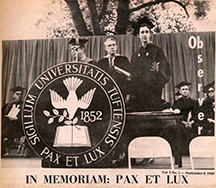
Tufts Queer History Project
The Tufts Queer History Project started as a Tufts Summer Scholars Research Project proposed by the fifth Lesbian, Gay, Bisexual and Trans Center Director, Dona Yarbrough in 2006. Elena Mead, then a sophomore, was awarded the research scholar grant and worked with the director on the project. This website is the culmination of Elena's work. The main objective of TQHP is to both reflect on the achievements and challenges of the Tufts queer community, and to connect our past with our present.
The timeline starts in the 1969-1970 academic school year. This choice was made based on national trends in queer history, which were loosely paralleled at Tufts. While the U.S. gay liberation is often said to have started with the Stonewall Riots in July 1969, Tufts gay liberation may have started out at the 1969 graduation ceremony, when a student came out on stage.
This website allows students, staff, faculty and alumni at Tufts to be heard. In a special interactive element, several documentaries outline key events in the Tufts queer experience. In later years, more information has been collected and displayed for general use. If you are interested in adding to the Tufts Queer History Project, either through your own research or a class project, please email lgbt@tufts.edu.
1970's

June 1, 1969: Student comes out during graduation
This event is landmark in the Tufts Lesbian, Gay, Bisexual and Trans community. It predates both the famous Stonewall Riots of late June of 1969 as well as the establishment of the first gay group on the Tufts campus. The bravery of this male student stands a significant beacon in our history in a time where homosexuality was considered taboo.
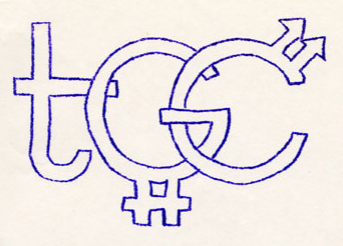
Spring 1972: Tufts Gay Community formed
In 1972 , Tufts' first gay organization was formed. In an Observer article, members described the Tufts Gay Community as a group wanting to create awareness and visibility of homosexual students on campus. While TGC consisted of both men and women, the term "lesbian" was at the time considered too radical to be in the organization's title. Many members would take action in different ways, speaking out in classes and writing articles in the Tufts daily newspaper, titled the Observer. Confidential meetings were held regularly in East Hall Lounge, allowing students to begin to fight for their rights as homosexuals. Students who did take these steps faced many incidents of harassment. There are several accounts of name calling and threats from different parts of campus, as well as vandalism in dorms. This did not faze the TGC, which would grow exponentially in the years to come.
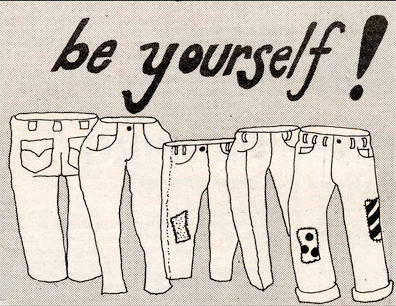
Spring 1976: Blue Jeans Day established
Blue Jeans Day was Tufts' first gay awareness campaign. Put together by the newly established Tufts Gay Community, Blue Jeans Day made a campus-wide impact. In its early years, Blue Jeans Day was organized randomly on particular Wednesdays. In the late 80s the event became a part of a larger awareness month. It continued to occur until the late 90s. The key part of the event was its effect on those who participated.
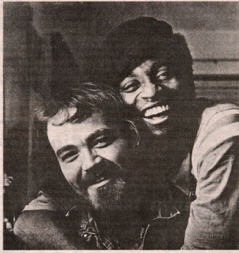
March 17, 1977: First student article written about homosexuality
An openly gay student's article was published in the then daily newspaper, called the Tufts Observer, in 1977. The author, Steve Cantrell, focused on several issues concerning homosexuals in the Tufts community and those who lived in the "real world." He explains that for both groups, being gay is just another way to love someone. Cantrell's article, another brave act that happened during the more quiet years for gay people on campus, represents one example of gay awareness through publications.

February 1978: Tufts students allowed to enroll in ROTC training at MIT
1980's
September 1980: Curtis Hall used as drop-in center
According to articles in the Tufts Daily, the Tufts Gay Community started what would be known as the first drop in center at Tufts for homosexual students in the beginning of the 1980-1981 school year. The center, located in Curtis Hall, was staffed by the members of TGC and was open for those students who were struggling with their sexual identity.
Curtis Hall now currently houses several student publication centers and media groups. It also houses the popular cafe, Brown and Brew
October 29, 1980: Anti-gay graffiti found on the Memorial Steps
Anti-gay harassment was taken to a new level in 1980 when the words "FAGS MUST DIE" were spray painted on the Memorial Steps. The community at large was outraged both at the graffiti and its longevity on the steps. The graffiti was not removed for sometime, and after a huge outcry, was removed. No perpetrators were found in the incident, nor does an image of the actual words exist.
Two articles record the incident. The first article is from the Tufts Daily, and the second is a letter addressed to Dean Bobbie Knable by a recent alum.
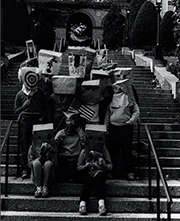
1981: The Tufts Gay Community decided to include Lesbian in the name of the formal organization
The pictures here are from separate years. One shows one of the early Tufts Yearbook photos of the group. While it was slowly getting easier to be gay in the U.S., there was still a lot of anxiety about being "out". This explains why TGLC members decided to wear bags over their heads. The second image is an announcement of a TGLC general interest meeting.
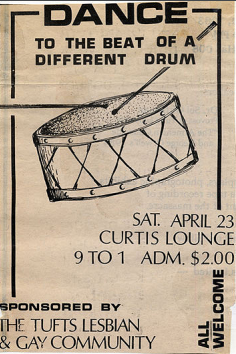
April 23, 1983: First Dance Advertised to the Public
The first dance that students organized was held in April 1983 (perhaps during Gay Awareness Week). It was a wild success; over 100 people attended the event that was held in Curtis Hall (location of the student drop-in center). At the same time, harassment was still occurring on campus. According to an article in the Daily, the cannon was painted with anti-gay graffiti, such as "gays go home." This harassment never seemed to stop the planning for other dances, which would take several forms. View the debutant cotillion (formal) invitation celebrating the 16th birthday of the TLGC student organization.
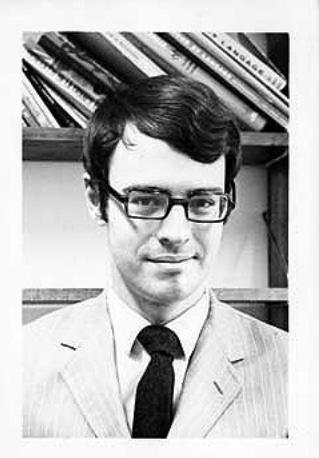
March 7th, 1984: Professor Frederick Shelper dies from AIDS
A year before Ryan White and Rock Hudson made "AIDS" a household word, the disease hit the Tufts community hard when esteemed French Professor, Frederick Shepler, died in 1984. Although news accounts did not mention that Shepler was gay or that he had died of AIDS, many at Tufts knew the truth. This local tragedy, along with the national tragedy of the Regan government's refusal to acknowledge the scope of the disease, marked a turning point for students in TLGC. They reacted with AIDS awareness programs, protests, and forums.
The articles below give a sense of the kind of programming that both administrators and students were organizing during the mid to late eighties. The first event that students organized was held in February 1984, when the TLGC hosted a forum including the founder of AIDS Action in New York. Many of these programs were meant to teach the community the difference between fact and myth concerning HIV/AIDS.
April 18th, 1985: Tufts Center Board (TCB) recognizes TLGC as a student group
The Tufts Center Board (TCB) voted to give TLGC official recognition as a student group in 1985. While TLGC had been a group for over ten years official recognition meant that TLGC would have TCB funding allocated every year for programming as well as a voting member on the senate. The community was very proud of this achievement, which they hoped would help expand programming beyond the TLGC group and connect the TLGC to other student run groups.
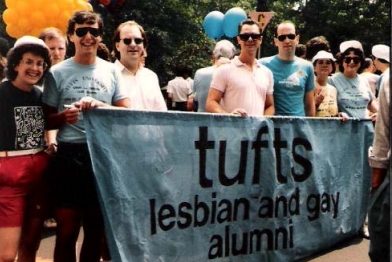
October 20th, 1987: Students march in the DC March on Gay Rights
Students from TLGC represented Tufts University in the National Lesbian and Gay March held on October 11th, 1987. It was the largest demonstration on Gay Rights to date, and hoped to raise awareness on gay rights in the United States. It was not the first time that a group of students marched in a gay pride parade. A year before, TLGC alumni organized a group to march in the New York City Pride, held June 29th, 1986.
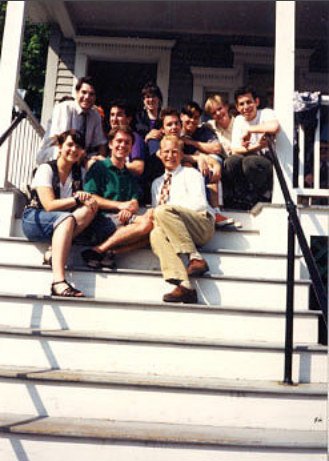
October 29th, 1987: Drop-in center moved to Hayes House
In the late eighties, TLGC moved programming operations to the Hayes House on Chetwynd Rd. LGB awareness programming was still planned at Hayes House until the mid-90s. When the LGB resource center was established in 1992, Hayes House would become a center of social activities, which would continue until the late 90s.
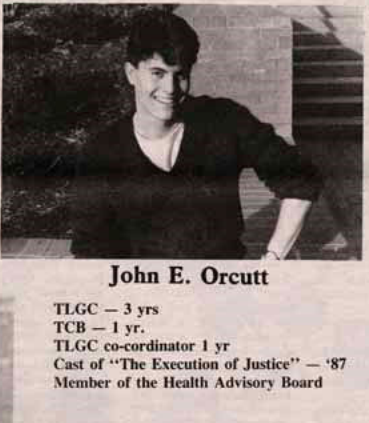
Homecoming Celebration - Gay Man Ran for King
Homecoming at Tufts, like many other universities, is an annual event where the sports teams play home games and the Homecoming King and Queen are crowned. At Tufts' 1987 Homecoming celebration, the annual competition for the Homecoming King was lightened when an openly gay man ran for king. Unfortunately, he did not win the title.
This appears to be the first time an openly gay man ran for Homecoming. A few years later, a lesbian ran for Homecoming Queen and was also met with defeat; However, in 2003 the LGBT community experienced a big win.
April 5, 1988: Pride Month was a facelift for the annual Gay and Lesbian Awareness Month
Programming would continue to occur in April every year, however switching the name to Pride Month showed the immense change in the attitude of TLGC. For many years the programming was very educationally focused; however, many events were changed to celebrate being gay and coming out. This shift did not negate the educational purpose of Pride Month, but it did show that the group was beginning to form a very strong out and proud community.
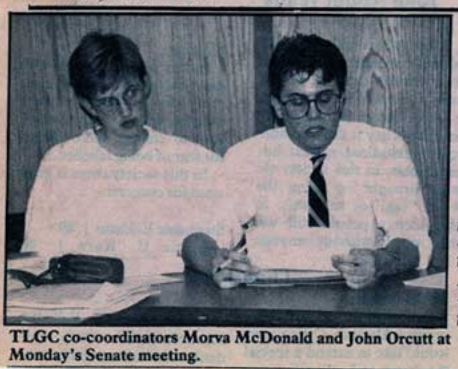
April 6, 1988
By the mid eighties, TLGC's visibility on campus had increased through many ongoing programs and events. While these programs and events ran successfully, gay and lesbian students still fought for a staff member to increase programming and support services. The most important role for the proposed coordinator would be to implement administrative level programming and work to create more rights for students on campus.
Efforts were focused on receiving money from the Tufts Community Union. After much debate, the student senate decided to fund a coordinator for the Lesbian and Gay community. In a statement made by senators, the funding allotted to TLGC was a way to push the Tufts administration forward on matching the funding given to the part-time employee.
September 1988: Donna Penn hired as first coordinator
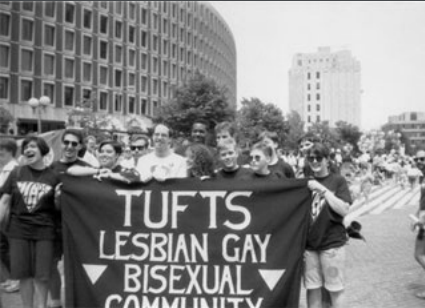
October 20th, 1988: TLGC renamed to TLGBC
When the group decided to add the letter 'b' for bisexuality, it best reflected the new bisexual movement on campus. Many leaders over the next few years were bisexual and advocated for awareness of the bisexual community. This work was seen through programming that TLGBC did during the early 90s and also through a series of Daily articles titled "The Other Side." Under the title "Bisexuality Emerges," those students who did identify as bisexual wrote articles on what it mean to be bisexual and the separation between bisexual myth and fact. "The Other Side" column was a series that let LGB students speak about their experiences and the reality of being different. The articles began in the fall of 1987 and continued until the mid nineties.
December 1, 1988: Faculty Staff Caucus formed
The Gay and Lesbian Faculty Staff Caucus was first formed as a discussion group among several professors and staff members. The recently hired coordinator, Donna Penn, decided to bring together the group to see what Tufts faculty and staff thought about being gay in their professional fields. In subsequent years, the group became a strong co-partner and supporter to the efforts of LGBT students to create more resources on campus.
One of images below is of caucus meeting minutes. The minutes outline some of the activities the group was involved in during the nineties, including acquiring partner benefits for lesbian and gay faculty and staff. The group later created an initiative with students that established the Lesbian, Gay, Bisexual Taskforce for student life.
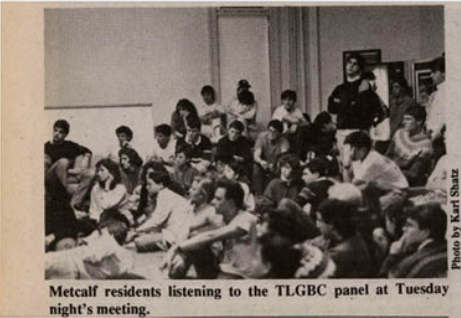
February 7th, 1989: Harassment in Mecalf Hall followed by forum
In the fall and beginning of the spring semester of the 1988-1989 school year, several homophobic incidents, including homophobic graffiti, occurred in Metcalf Hall. In response to the incidents, the administration enlisted TLGBC to coordinate a discussion about homophobia with residents in February. As the articles below make clear, many students were frustrated with the enforced mandatory attendance at the discussion, among other issues with the administration's position regarding the bias incidents. Nevertheless, the event did require some students to interact with the LGB community for the first time.
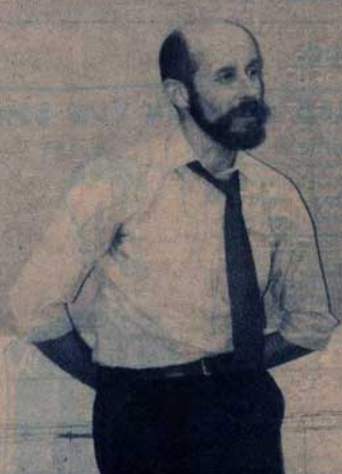
Fall 1989: First University recognized gay history class taught
In 1989, Tufts devoted the grants from the Jean Mayer Innovative Education Fund toward gender and race courses for students. Among several proposals accepted was the first solid gay and lesbian history course. Professor Howard Solomon, who was no stranger to teaching gay and lesbian studies at Tufts, was slated to teach the course. Solomon, who had started out teaching about gay and lesbian movements in his Social Deviance in European History in the 1970s would be key in later movements to expand the lesbian and gay curriculum further for students.
December 10, 1989: Students protest AIDS inattention at Goddard Chapel
1990s marked a time of political vigilance in the LGB community. In addition to increased student awareness about lesbian, gays and bisexual students, students began to look beyond Tufts. Even though information about the causes of HIV/AIDS was well-publicized in popular media, there were still those in the administration who saw the illness as a "gay disease." The protest occurred during a Catholic mass and targeted both the Catholic church's inattention to AIDS and perhaps the national inattention to AIDS. Those students who participated in the events fully explained themselves and their motives.
1990's
December 4, 1990: Radical group QUEER posters campus
The action that this group took was considered "politically" minded. Though programming an important asset for the LGB community at Tufts, QUEER would reveal the need for an even more politically aware campus. QUEER formed quickly as a unique splinter group of TLGBC at the end of 1990. It is unknown what the motives of the group were or even who its members were. Nevertheless, their presence was made visually clear through the suggestive flyers they distributed throughout the winter. Since the posters were regarded as sexually explicit, the administration did look into the issue; however, nothing more was discovered about the group. The poster ceased after January and did not reappear. Two articles about this group outline the actions took by Dean Bruce Reitman. The actions taken by Dean Reitman were the subject of confusion and debate, which is shown in the articles below. Though awareness programming was an important asset for the student group TLGBC, QUEER criticized the group's political position, revealing the need for an even more politically aware campus.
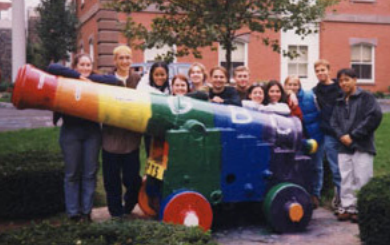
October 11, 1991: Tufts holds first Coming Out Day
National Coming Out Day was established one year before Tufts began to celebrate it. The purpose of the day was to encourage students on campus to come out and be proud of their identity. The day promoted the idea that Tufts had a supportive and active LGBT and ally community. Today, the event still holds enormous significance for the LGBT community. According to some current students, Coming Out Day allows many closeted students to become aware of the LGBT community at Tufts. This picture shows students in 1998 in front of the cannon. Painting the cannon became a long standing tradition for LGBT awareness events, and was incorporated smoothly into Coming Out Day. The event itself is celebrated on the Wednesday closest to the National Coming Out Day (October 11th). Each year a number of faculty, staff and students rally and hold an open mic ceremony.

November 4, 1991: Hundreds of students rally for gay rights on campus
The rally on November 4, 1991 was a turning point for students, staff and faculty at Tufts. At the time the student group TLGBC was still functioning without proper resources and coordinator Donna Penn was still being funded through the student government. From the point of view of the students, staff and faculty who supported the growth of the LGB community, it was time for the administration to take the initiative to change student life on campus. This event was incredibly successful in exposing the need for LGB advocacy on campus. The rally was deemed so successful that the Boston Globe wrote a story about its impact on campus. One of the rally's goals was recognized by the administration when they approved funding for the part-time LGB center director.
Spring 1992: LGB Taskforce
The Lesbian, Gay, and Bisexual Taskforce was a collaborative effort between administration, faculty, staff and students to improve student life at Tufts. The taskforce was formed in 1992 by Vice President Mel Bernstein and chaired by Howard Solomon and Marilyn Glater. Extensive research was done in the course of a year, and a full report was then given to the administration as well as the student government. The report discussed many aspects of student life that were needed at Tufts, such as the improvement of the LGB resource center and housing options. Additionally, the taskforce recommended partnership benefits for employees and the establishment of a well-rounded selection of LGB classes.
Read the results and resolutions of the Taskforce
- Cover Letter, Vice President Mel Bernstein
- Recommendations Summary 1
- Recommendations Summary 2
- Recommendations Summary 3
- Recommendations Summary 4
- Text Version of Recommendations Summaries 1-4
- Report Table of Contents
- Members of the Task Force
- Introduction 1
- Introduction 2
- The Goal and the Challenge
- The Current Atmosphere at Tufts 1
- The Current Atmosphere at Tufts 2
- The Current Atmosphere at Tufts 3
- The Current Atmosphere at Tufts 4
- The Current Atmosphere at Tufts 5
- Work Complete or in Progress toward the Goals of This Report 1
- Work Complete or in Progress toward the Goals of This Report 2
- Recommendations
- Services; Curriculum, Teaching, Advising Issues
- Students; Benefits
- Benefits 2
- Endnotes 1
- Endnotes 2
- Appendix 1 (Charge to the Task Force on LGB Issues Spring 1992; Appendix 2 (Mission Statement: University Accreditation Report)
- Appendix 3 ("Equal Employment Opportunity" Employee Handbook 1992)
- Appendix 4 ("Policies, Procedures, and Responsibilities" The Pachyderm 1992-1993)
- Appendix 5 (Reports of Other Universities and Colleges)
- Appendix 6 (Survey of Arts and Sciences Courses Dealing with Gay, Lesbian, Bisexual Issues)
- Appendix 6 (cont.)
- Appendix 7 (Arts and Sciences Resolution on ROTC)
- Appendix 8 (Proposed Notice Concerning ROTC)
- Appendix 9 (Selected List of Lesbian, Gay, Bisexual Caucuses of Scholarly Organizations)
September 24, 1992: Resource center established and Heather Wishik replaces Donna Penn
With substantial student and faculty backing, Dean Bobbie Knable established the first resource center. With the help of substantial student and faculty collaborative effort, Dean Bette Knable established the first resource center. The students now had an administrative coordinator and space to begin creating a library and archiving past events. Long time coordinator Donna Penn left sometime during this major change and was replaced by Heather Wishik who was funded through the administration on a part-time basis. It was not until the late 90s when the administration changed the coordinator position from part-time to full-time. The first LGB resource center was located in Lewis Hall, presumably in the basement where the Crafts Center is located today. A picture of the Craft Center is located below along with the formal letter announcing the establishment of the center.
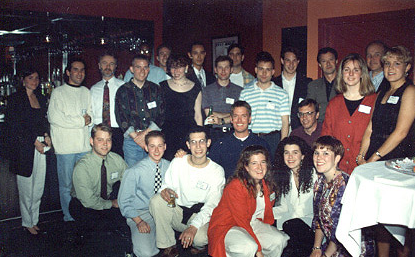
November 1992: Pride on the Hill established
Pride on the Hill, Tufts' LGBT and ally alumni organization, was established in 1992 to benefit gay, lesbian, bisexual, transgender, and straight ally students, faculty, staff, and alumni of Tufts University. LGBT Alumni organized the first kick off fundraisers for November 14th, 1992. Simultaneous events were held in Boston and Washington, D.C., and subsequent events were held in San Francisco and New York.
October 28, 1993: Facilities erases Coming Out Day chalking
The LGB community was disappointed, to say the least, when Tufts Buildings and Grounds workers washed away the October Coming Out Day chalkings. Chalking LGBT-friendly, and often slightly scandalous, words and phrases on the sidewalks all over campus was, and still is, a big part of the celebration of Coming Out Day for students. Students who inquired about the reason for erasing the chalkings were told that the order was carried out because the administration had seen some anti-gay chalking. The administration formally apologized to the LGB community and explained its actions. Furthermore, they decided to initiate a thorough chalking policy to avoid future problems and miscommunications.
Spring 1995
Students in TLGBC saw substantial changes during the mid-nineties. The departure of director Heather Wishik left the center functioning without a director for a short period of time. While faculty searched for a new director, the LGB center moved uphill from Lewis Hall to some say more spacious quarters in basement of Carmichael Hall. Charlene Waldron was hired soon thereafter as the third part-time director.
Spring 1997: Charlene Waldron Leaves
April 10, 1997: TLGBC renamed to TTLGBC
The student group changed its name yet again in order to acknowledge transgender members of the community. The Tufts Transgender Lesbian Gay Bisexual Collective quickly became known as “TT” to insiders. Below is one of the first articles to use the new name of the group. It was a thank you to all those on campus who have supported the group throughout the years.
Fall 1997: Judith Brown hired as the first full-time coordinator
Judith Brown became the replacement for Charlene Waldron in the spring of 1997. In addition to hiring Judith, the administration changed the position to full-time director of the Lesbian, Gay, and Bisexual Resource Center. The effect of this change was that the LGBT community could create a new level programming and initiatives. It also meant that they could look beyond the establishment of a center and on to other issues in the community.
Women's Group formed
Women's Group is a student-run discussion group that was formed for those lesbian and bisexual women who were interested in meeting others and talking about issues in a private setting. Women's Group was the first group established out of the many groups that now exist at Tufts, which now include Men's Group, Queer Students of Color and Allies, and Bisexual Student's Group.
March 5, 1998: Tufts Community Union signs same-sex marriage petition
After the development of a full-time LGB Resource Center Director, the community's next initiative was the legalization of same-sex marriage. At the time, same-sex marriage was not legal anywhere in the U.S. Students persuaded the student government, Tufts Community Union, to sign its name to a petition on March 5, 1998. It asked for the legalization of same-sex marriage. This action was successful, although marriage would not be legalized nationally.
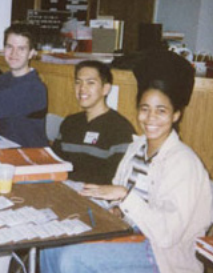
March 28, 1998
The Safe Colleges Conference came to Tufts in March of 1997. Initially the conference received state funding, and its purpose was to promote safe and politically aware students, staff and faculty. The first statewide conference was called "Sound Mind, Sound Body, Sound Off" and had a budget of approximately $65,000. It was a huge success and formally became a major programming effort for the LGB Resource center and its students. While the original 5-year state funding commitment was cut in 2000, Safe Colleges continues to this day, but with a much smaller budget provided primarily by Tufts University. The conference every year consists of several workshops created by staff and organizations on and off campus and a keynote speaker. In 2000, Activist Leslie Feinburg spoke at the third annual Safe Colleges event. Today the conference still happens every April during the "Gaypril" month programming. The pictures below show day-of events including registration and a book signing with Leslie Feinburg.
Fall 1998: Men's group formed
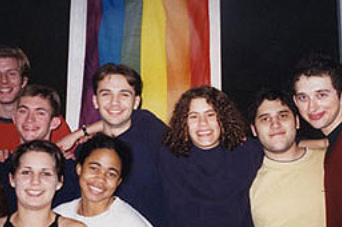
September 1998: LGBT housing established in Latin Way (Rainbow House)
The Tufts Rainbow House was established after much student advocacy about the need for safe housing. The purpose of LGBT housing on campus was to provide safe housing for LGBT students, particularly in light of the high number of bias incidents that continue to occur in residence halls. However, the house has always been open to straight allies as well, and usually one or more allies live in the house each year. The students who founded the Rainbow House also fought for mixed-gender rooms, but the administration did not accept that proposal. The Rainbow House was first located in Latin Way in the A Tower. During the renovation of Latin Way in spring of 1999, the Rainbow House moved uphill to the Hillside Apartments where it remains today. Two pictures show the first students who lived in the Rainbow House.
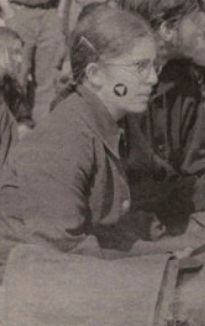
February 28, 1999: Gay students assaulted at Tufts
This event demonstrates the enormous support system that was created for LGBT students on campus. An unknown suspect physically assaulted two gay men near campus. When word got out, almost everyone sprang to immediate action. As described in the four articles below, all segments of the Tufts community -- the administration and the president, students, faculty and staff -- banded together to find the suspect and to support the LGBT community.
Spring 1999: Last Blue Jeans Day
April 22, 1999
The student senate proved to be helpful and supportive again when it passed a resolution to eliminate heterosexism and homophobia at Tufts. The resolution asked for several administrative polices to be changed as well as for the creation of LGBT awareness programming for faculty and staff.
2000's
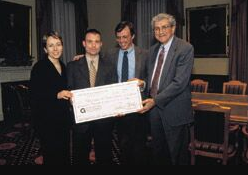
February 3, 2000: Pride on the Hill Award Established
The Pride on the Hill organization's efforts to raise money for current undergraduates culminated in the establishment of the Pride on the Hill Award. The new award enabled a student to be recognized for contributions to the LGBT community at the annual general awards ceremony held each spring. The Pride on the Hill Award is awarded to a student who has completed exemplary work to a greater understanding of LGBT awareness and identity.
April 4, 2000: Student files homophobia claim against the Tufts Christian Fellowship
In the end of 1999-2000 year, the Tufts Christian Fellowship allegedly discriminated against a female member based on her sexual orientation. Then junior Julie Catalano was to claim to a leadership position in the following year; however, the group decided that she would not be allowed to become a leader based on her belief in homosexuality. Catalano filed a homophobia claim against the group, resulting in hearing by the Tufts Community Union Judiciary (TCUJ). The TCUJ ruled in May 2000 that the TCF had indeed discriminated against Catalano based on her sexual orientation. However the wording of the non-discrimination policy was very ambiguous regarding the “practice of specific beliefs,” which helped effectively over turn the ruling of discrimination in the next year. TCF was revoked certain abilities such as funding, but was reinstated as a group in the coming year based on the wording of the non-discrimination policy. Further action was taken in the next year, when a group of students took over the University Admissions Building.
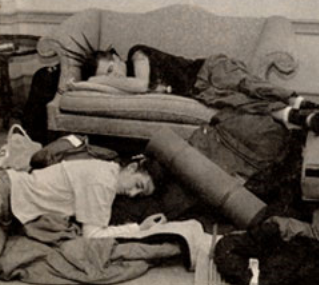
November 11, 2000: Sit in at Bendetson occurs
In response to the homophobia claim that was made in the previous spring as well as the unsuccessful attempt to change the non-discrimination policy, a group called Tufts Students Against Discrimination (TSAD) was formed to fight against discrimination at Tufts. In the beginning of fall of 2000, the students organized a sit-in at the Tufts Admissions Building, called Bendetson Hall. They took over the building until the language in the non-discrimination policy better fit the needs of all students regardless of their belief system. The action was successful and very visible. The students took over the building for two days and one night and were met by significant administrative action on revising the policy.
Fall 2001: Question Your Sexuality formed
Question Your Sexuality (QYS) was a support group for those struggling with sexual or gender identity. It was held weekly, much like the discussion groups that formed in the late nineties, but was replaced with Director's Office Hours in the Campus Center, which was created by the fifth director of the LGBT Center, Dona Yarbrough.
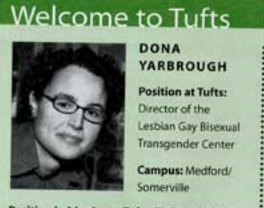
January 2003: Dona Yarbrough was hired as the fifth LGBT Center director
Making use of her background in academics, Dona is currently working on developing queer studies at Tufts, and on educating the entire university about changes to university policies which she initiated.
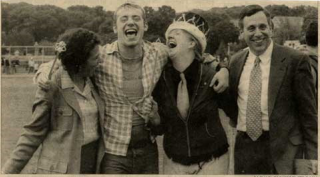
October 2003: Tufts Queer Homecoming
The 2003 Tufts Homecoming had an LGBT twist at the crowning of Homecoming King and Queen. Two openly gay seniors, Tyler Duckworth and Stacy Ulrich, successfully ran for Homecoming King and Queen, respectively. During the crowning, the two students switched crowns, thinking it more fitting that Tyler be "queen" and Stacy be "king." Tyler later became a character on MTV's "Real World."
Fall 2003
New Groups Formed
Queer Students of Color and Allies (QSOCA) formed
In the past few years, the new student discussion groups have been formed to accommodate the fast-growing and increasingly diverse LGBT community. Director Dona Yarbrough created a group focused on the intersection of LGBT and racial issues, which is open to all students regardless of race or sexual orientation. David Wu became the first facilitator of the group and came up with the name Queer Students of Color and Allies (QSOCA).
Emerge formed
Emerge was formed by several upperclassmen in the fall in the hopes of increasing LGBT activism on campus. As a complement to the general student group, TTLGBC, Emerge focused on initiatives on and off campus including same-sex marriage and transgender issues. The group was disbanded shortly after its creation; however, the spirit of the group was not lost. TTLGBC decided to re-integrate activism into the their group, striving to serve both a social and a political function.
Fall 2004:
Transgender Housing Policy accepted by ResLife
The newly hired director, Dona Yarbrough, worked on her first initiative to create a safe living space for transgender students on campus in the fall of 2004. Dona requested that a specific transgender housing policy be put in place for those students who requested it. Along with alumni, Kelly Sanborn, Dona met with Dean Bruce Reitman and the Director of Residential Life, Yolanda King, to develop a policy. After these meetings, the Transgender Housing Policy was formally established.
Current Transgender Housing Policy
Bisexual Student's Group formed
Bisexual Student's Group is the newest established discussion group available to students at Tufts.
Blood Drive controversy on campus
The blood drive controversy occurred when Tufts senior Matt Pohl filed an individual complaint against the Leonard Carmichael Society for sponsoring blood drives on campus which, claimed Pohl, violated the Tufts nondiscrimination policy by unfairly discriminating against the gay and bisexual male population. FDA policy states that any man who has had sexual intercourse even once with another man since 1977 is not allowed to give blood, even if that man has repeatedly tested negative for HIV. At the time, the Red Cross fully and publicly supported the FDA policy.
In a compromise mediated by the Dean of Students Office, the Leonard Carmichael Society would become a "host" rather than a "sponsor" of the Red Cross Blood Drive, and would include language specifically acknowledging the controversy on all advertising and in handouts distributed at the drive. The agreement is to remain in place until "there is generally accepted information demonstrating the validity or lack of validity of the current policies governing blood donation or until the policies of the FDA and American Red Cross change to eliminate the controversy." The LGBT student community was strongly divided over the complaint. Some felt the complaint might prevent people from giving life-saving blood, which was seen as a greater good. Others thought that allowing multiple "exceptions" to the non-discrimination policy (an ROTC exception already exists) set a dangerous precedent and argued that it was up to the FDA to consider the greater good of getting more blood by altering its own policies. Many more students fell somewhere in the middle on this issue.
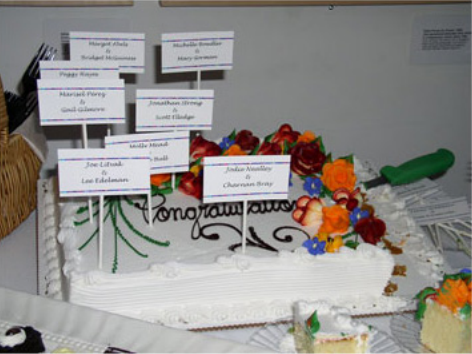
University holds reception for gay marriage
In the wake of the recent legalization to same-sex marriage in Massachusetts, the Tufts Administration decided to sponsor a reception for LGBT faculty who, during and after May 2004, became legally married. Same-sex marriage became a powerful way to connect students, staff and faculty to LGBT issues off campus. In the previous years, Tufts students, both from the LGBT community and from the general community, fought in support of the legalization of same sex marriage.
September 2005
TTLGBC, now in its 33rd year as an organization on campus, changed its name once again in order to include new identities and to signal the increasing use of the word "queer" among students as an umbrella term for any non-normative sexual or gender identity. The change to Queer Straight Alliance, or QSA, also explicitly acknowledged the crucial role of straight allies in the group, and was meant to suggest familiarity to many incoming students who were part of GSA, or Gay Straight Alliance, groups in their high schools. The group also decided to disband the political group Emerge and re-incorporate activism as part of the primary mission of QSA.
October 2005
In the spring of 2004, students organized the annual Day of Silence around transgender awareness. During the event, organizers of Day of Silence collected signatures for a petition that would ask President Larry Bacow to add gender identity and expression into the Tufts University non-discrimination policy. Following this advocacy, the director of the center, Dona Yarbrough, urged the administration to consider revising the policy. The administration responded with the formation of a committee, chaired by Dean Bruce Reitman, which would look at the issue on campus. The result of this action was the unanimous acceptance of the revision of the policy in October 2005, when President Bacow brought the issue up for vote with the board of Trustees. Visit the Tufts Office of Equal Opportunity for the complete Non-Discrimination Policy.
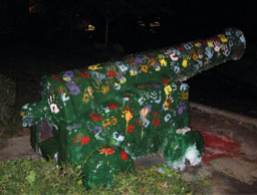
October 1, 2006
The LGBT community was shocked to find the cannon, painted the night before for Coming Out Day, defiled by strange graffiti. While the message on the cannon was ambiguous in meaning, the feeling of violation and the message of hate seemed quite clear. The police quickly responded, and the act was officially deemed a bias incident, while the LGBT community and Facilities Office worked to remove the defiling words. In cooperation with B.E.A.T., the Bias Education and Awareness Team, QSA and the LGBT center sponsored an rally and re-painting of the cannon with a message against hate. Many members of the Tufts community, including the President and Provost, participated by signing a huge banner denouncing bias and hate.